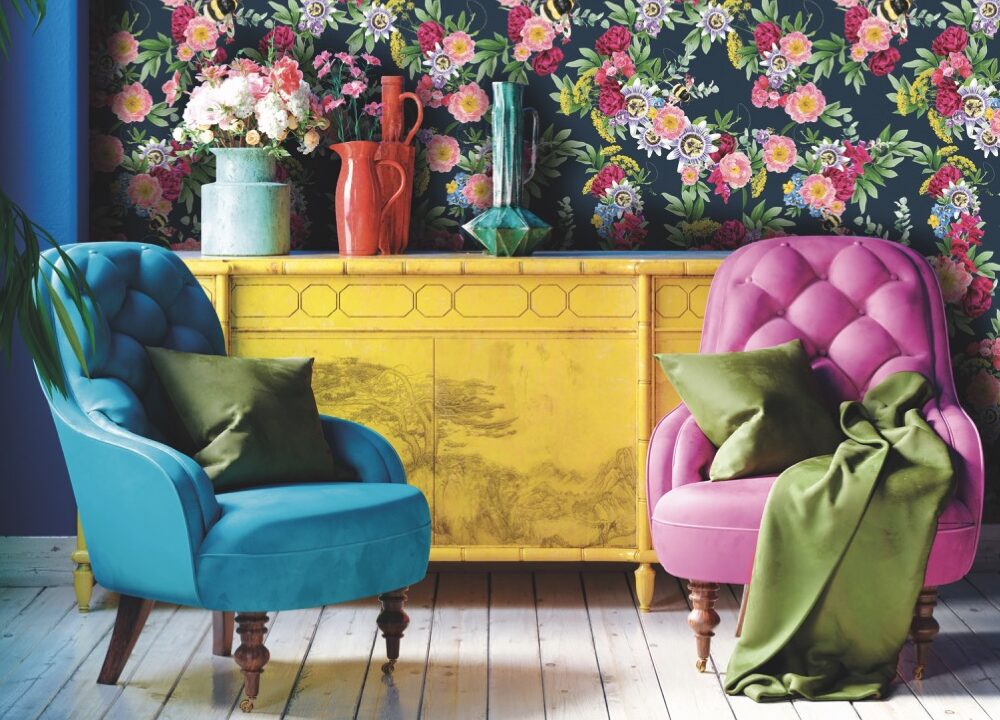Embrace the interiors trend of energising colours and uplifting tones, says Fiona Cumberpatch
Lead picture Lola Design
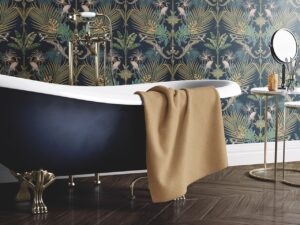
Lime Lace
For the last decade or so, neutral homes have reigned supreme as the ultimate in interior goals. Inspired by influential designer Kelly Hoppen, the self-confessed Queen of Taupe, along with Chrissie Rucker, founder of popular high-street brand The White Company, a palette of naturals and shades of grey have long been seen as the epitome of minimalist elegance. Perhaps it’s unsurprising; with no worries about matching or clashing, neutrals are straightforward to use and soothing to live with. The problem is that they can start to look bland and drab. Now the tide is turning and there’s a move towards bolder, more exuberant interiors that incorporate rich and colourful hues.
A trend that began in high-end restaurants and boutique hotels is now suffusing the high street with a radiant array of peacock blues, saffron yellows, plum, aubergine, jade, pomegranate, burnt orange and spicy terracotta tones. These can be employed sparingly or as an all-out colour drench, depending on taste, but adding at least one strong shade is guaranteed to introduce personality into an interior space.
For many people, the greatest obstacle to creating a more colourful interior is knowing where to start. Pauline Fox, home designer at Neptune Cambridge, advises taking time to assess each room. “I tell clients to ask themselves how they want the space to feel. Do they want it to be wide open, light and serene, or cosy and comforting? Colours are very emotional.”
Caution with colour
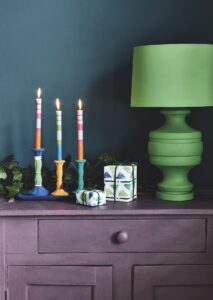
Chunky candlesticks from Annie Sloan
For a major investment such as a kitchen, being cautious about colour is understandable. “People are reticent about choosing darker shades, but these can be incorporated in a gentle way, with smaller splashes of colour,” explains Pauline. “A popular method of achieving the look is by infusing colour into just a kitchen island. That way, you’re not committing to an entire scheme. Accessories can be added that pick up hints of the same shade. In living rooms, this could be the introduction of cushions, throws or perhaps a footstool.”
For those on a tighter budget, paint is a cost-effective option for bringing more colour in. “It’s the easiest way to transform your room, and it’s not permanent, so can easily be switched up if you get sick of it,” says Pauline. Neptune presents a collection of paint in seven families of colour, which encompasses 28 shades. “This makes it easier for customers to choose a palette,” Pauline explains. Twice a year, seasonal swatches are added; recent additions include Bracken, Saffron and Cactus. “These colours can sound terrifying, but we use swatches and visuals to build our customers’ confidence and help them make the choice that’s right for their home.”
Don’t be frightened
This season, there’s a noticeable shift towards spicier colours that traditionally have been considered difficult to live with. “We’re seeing a 60s and 70s vibe coming through with shades of mustard, cinnamon and aubergine,” says Cambridge-based interior designer Catherine Harhalakis. “These are lovely, warm colours to work with; you needn’t be afraid to use them.”
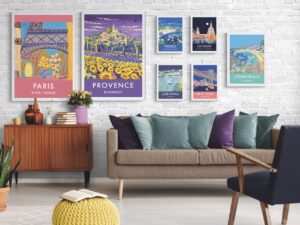
Bright travel posters from Wall Art Prints
Catherine is an advocate for colour drenching; when the walls, ceilings, doors and woodwork of a room are all painted in the same hue. “I’m not a fan of the single, signature painted wall,” she explains. “If the intention is to be colourful, I say go for it and do the whole room! It can have a dramatic, yet surprisingly calming effect.” A good way to try out this trend is to adopt it in a smaller room, such as a downstairs loo, utility room or study. If it feels right, you can then extend it to larger spaces too.
Play with patterns
While large blocks of strong colour can feel overwhelming, patterned fabrics and textiles offer a milder way to usher in bold shades. These can be mixed and matched for an eclectic, boho mood. “The general rule is to pair large patterns with smaller ones that use the same colour palette, so it’s not jarring,” Catherine adds. “I would go for three to five large and small prints, linked together with a common colour theme. Flow and continuation are important in creating a harmonious space.”
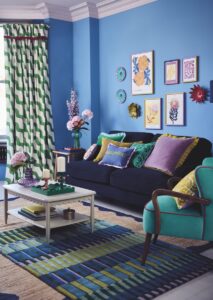
Dunelm
High-street stores such as Dunelm, H&M Home and Zara Home are good sources of inexpensive soft furnishings, ceramics and art prints to help achieve the look. Designer Sophie Robinson’s new collection for Dunelm pairs riotous colours and exuberant patterns in rugs, runners, bedding and small pieces of furniture, while H&M and Zara both offer a choice of darker, earthier shades such as chocolate, ginger and deep purple. The only rule? Go with your instinct.
“I wouldn’t rule out any colour for any home in any iteration,” says Neptune’s Pauline Fox. “You might need to be mindful about north- or east-facing rooms and the effect on interior light, but otherwise my advice is to just lean into it.”
Her words are echoed by Catherine Harhalakis. “I encourage clients to be playful and bold with colours, whether they live in a period or a contemporary home,” she says. “If something is calling to you to do it, be brave. Your surroundings will have so much more personality if you do.”
Stockists
Annie Sloan
anniesloan.co.uk
Dunelm
dunelm.com
Lime Lace
limelace.co.uk
Neptune
neptune.com
Pooky Lighting
pooky.com
Sofa.com
sofa.com

